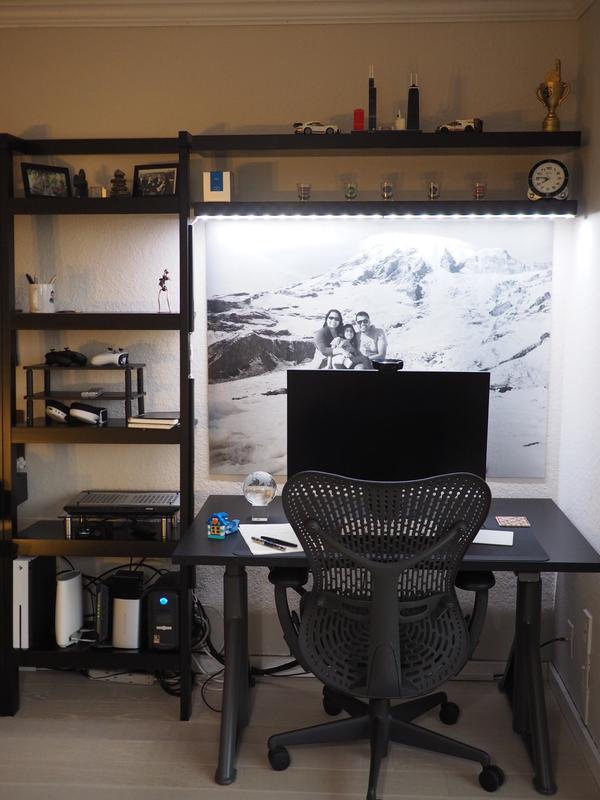Before anything else there were our colleagues from Wuhan that were expressing their concern about an illness that was effecting their friends and family back home. Within a month, there was a reported illness of a returning Amazon employee followed soon after of an outbreak at a nursing home in Kirkland, WA. It escalated quickly from there. There were cases reported at some of the corporate offices of the major Seattle area employers and in the first week of March they almost universally issued guidance to stay home if you can. A few weeks later schools shut down and employers changed their tune to “you should stay home.” Thus began the began the biggest change in how many of us live and work since the industrial era’s drive to separate home and the workplace.
The abrupt shift in how life was structured was not an easy transition, especially in the early days when the data was conflicting, essentials were hard to find, everyone and everyplace was figuring things out on the fly, and we still harbored hope that this was short-term. More than eight months later the patterns are better established and it seems worthwhile to take stock of what has worked and why it seems to have been easier for some and incredibly difficult for others. Nothing here is universal and mostly applies to the experience of corporate office types. It’s also almost entirely based on my observations and conversations.
Maslov’s hierarchy of needs doesn’t stop applying just because it’s a work setting. You still need the basics which are taken care of by teams of experts in a typical office setting. Therefore when remote it is imperative to rebuild the base of the pyramid and if you can’t, or it’s not possible, even the most remote friendly job will be a frustrating disaster.

Densely packed full of chatter and the clank of mechanical keyboards is not my ideal zone.
For me the primary importance is space. I need a place where I can setup shop for the whole day, wander away from, stack up a few cups of coffee and water, and that lacks disrupting noises. It also needs to be comfortable; even compared to sleeping, work consumes the most hours in the day. Most companies of any size make their purchasing decision with an eye towards ergonomics with a focus on adjustable components for long-term comfort. The couch is great for a few hours, but hour after hour, day after day, your back just won’t feel right. So find a space then make it work. Take advantage of work reimbursements, get monitor, flip out the occasional chair for one that’s designed for 8+ hours of sitting, and a noise canceling headset. Think of everything that you rely on in your office and make sure you have a functional equivalent in your office environment.
Of course, office furniture is not cheap and vendors are used to selling bulk deals to large corporations. The trade-off is that the quality of my workspace is only limited by the size of my budget. At work, it doesn’t matter how well I do, I’m going to get the stock desk, chair, and monitor. For my home office, I don’t have to think about what will work for a dynamic, ever-changing workforce. I can set my space up just for me. I can set the lighting and temperature just the way I like and place my desk where I can look out a window. And while the furniture is expensive, the good stuff lasts. My Herman Miller chair has outlasted nearly every other piece of furniture that I’ve bought.

A place to work, put together exactly the way I like it.
Following space, the next is an environment that facilitates focus. This is the area where WFH in a pandemic differs from WFH in a normal situation. Without childcare, it is nearly impossible to work effectively with young children. If that doesn’t apply, or it’s been solved, there are still other roadblocks to focus. At work, I’m mostly surrounded by work. At home, I’m surrounded by everything that I like to do that is not work. Along with everything that I have to do that’s not work.
The workspace sets up the zone to work, which is why I consider it the first priority. On most days I simulate a commute by walking the dog at my day’s bookends, but I’m also not going to let the new found flexibility go to waste. Some days I wake up hyper enthusiastic and start working in my PJ’s, other days I’ll get a work out in before opening the work laptop. I’ve found habits work much better than structures for me. Being at home doesn’t make me a better multitasker. Folding laundry while on a call means missing important details while wrinkling my shirts. But doing a menial chore while stuck on a particularly thorny problem does increase the velocity of shower insights, though even in that scenario my primary focus is still work.
There are unspoken rules that come with an in person environment that help with focus. Headphones on means “do-not-disturb;” If you are no where to be seen, don’t expect a timely response; etc. Remote colleagues don’t have this context and every message could easily end up being a distraction, which puts the entire burden of determining urgency vs importance on you. This can be really challenging and doubly so if you pride yourself on responsiveness or work for micro-managers. Focus implies boundaries and if there aren’t any, remote work can feel like an inescapable slog.
The challenges focusing leads to the next key of success: communication. One of my favorite parts of Amazon is how we do meetings. The two highlights for me are the importance of explaining the decision making process and the acceptance that communication is work. How do you handle not being able to go into a room with a white board with your teammate? Taking a stab at it yourself and writing a design doc that explains the thought behind every decision goes a long way. As a bonus, there’s now a concrete artifact that can be discussed and updated to become the defacto documentation for the team. Even if this is not your team’s culture anyone in the meeting will be grateful for a few minutes to look over the doc.
It’s even more important to highlight the contributions of others, especially in conversations with shared leadership. Though it’s not only important for the boss
Ensuring that there is sufficient time for communication is harder to control. Even now I feel like I should have a significant amount of time to write code, but this is rarely the case. There are multiple projects that need my input, teammates that need help (and vis versa), and code reviews to complete. All of this is work too and in an office it’s visible implicitly. When it all happens via a series of 1:1 video chats, visibility has to be brought explicitly. It’s even more important to highlight the contributions of others, especially in conversations with shared leadership. Though it’s not only important for the boss, there have certainly have been days where I felt like I’m really struggling with my tasks only to hear my name mentioned multiple times in the following standup. We can sometimes be the worst judges of our own contributions.
Communication is not just about transactions, it’s also about relationships. Great teams also treat this as an aspect of work. I’m lucky to be on a team that builds in time for less serious conversations. We have a weekly 30 minute call where one team member presents whatever it is that they are interested in. Every other week we have an extended happy hour where we play some online game and get to know each other a little better. But even without full team support there are mechanisms to build relationships. Since we are no longer bound by the scheduling complexities of a physical conference room, take a few minutes to make small talk. Being suddenly remote lead to all sorts of interesting environments for my team and I learned a ton about them by just asking questions about their wall. It requires some level of proactive effort but, like any skill, it gets easier over time.
If space is the base of the pyramid with focus and communication forming the layers above, then trust is the final layer that leads to maximum productivity and remote work benefit. One direct outcome of building relationships is that it increases trust. It’s just human nature to trust the people we know more than the ones we don’t. Half our team joined after the pandemic started and everyone’s been able to be productive and make significant contributions. All while figuring out life changes and cross-country moves amidst a pandemic. All thanks to leaders and processes that foster trust and cooperation. Starting with trust, then validating if it was unfounded, makes a remote environment easier for everyone. For me the benefits are clear; we simply would not have been able to hire the people we have or accomplish as much as we did if we were all forced to sit in the same 24x12 space. When we were finally able to meet up for a socially distanced outing, the strangest thing was that it wasn’t strange.

The rainy ride back in whipping winds is less than pleasant after a long day in the office.
The last eight months have emphasized to me how negatively the commute and office environment impacted my overall job satisfaction. It’s something else to work on a problem I find compelling, with people who I admire, and in a space that works well for me. It’s wonderful that the morning procedure to get my daughter out of bed, a workout, a long work day, and cooking dinner can all happen on the same day without me having to be constantly calculating the trade-offs. I get that for many this hasn’t been the case and this has been a very difficult eight months. My situation is near ideal, with a kid that’s old enough to be mostly self-managed in a remote school day, with adequate space for three people to set up shop, with a job that only requires solid internet and a laptop, and a neighborhood environment that allows for social distancing without social isolation.
There has been a trend of businesses valuing productivity over conformity. More relaxed dress codes are in, core hours vs set hours, choice of equipment, and small independent teams are all steps companies have taken to allow their employees to shine. The data shows that the actual location of work has impact on productivity and they would have flexibility here too. Personally, I don’t see myself ever wanting to go back to an office. Home is just too nice.
